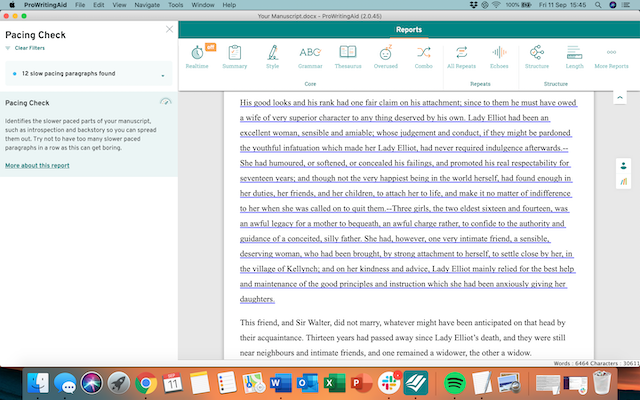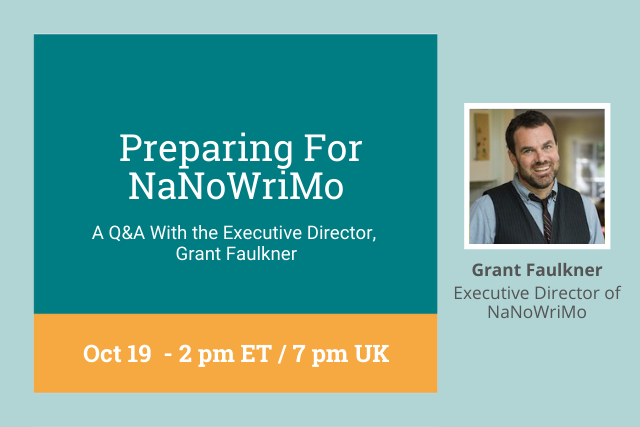
Are you ready for NaNoWriMo?
It’s the question most asked this time of year, right before National Novel Writing Month (NaNoWriMo) takes over the month of November.
If this is your first time doing NaNoWriMo, don’t stress out too much about it. It’s a huge learning process where you’ll discover what’s most important for you to be able to produce content on a continual basis to move forward towards your end goal of 50,000 words in 30 days.
The biggest lesson I’ve learned over the years is that it’s not so much about the end result. What you have at the end of 30 days will in no shape or form be a novel ready to print. Depending on your genre, novels can be 80,000 words and up. Just understand: you won’t be finished with it on November 30th.
What NaNoWriMo is about is learning how to let go—especially of your internal editor—and just write. Just go with the flow. Just let it happen. Because there will never be a novel if you don’t get it down on paper first.
It's also the time to learn more about how you like to write, and your environment is a big bart of this. I'm not just talking about where you like to write, though that is important. Your planning process, how you organize yourself, the people you have around you; all of this is part of your writing environment, and that's what we're focusing on today.
Read on to find out how to set yourself up for a successful NaNoWriMo by creating an environment that works for you.
1. Create a visual calendar for motivation.
Your most important writing environment is your headspace. It's important that you feel in control of your writing process so you don't get overwhelmed and demotivated. Your calendar can be as detailed or as basic as you like. You could write a short sentence describing what you're going to write, or how many words you want to hit. Or, you can go even simpler.
Use a standard desk calendar or a fancy whiteboard calendar to hang on the wall. Just get something with 30 days’ worth of boxes that you can put a big, red X through when you’ve reached your word count for the day. As you progress and the X’s start to join together in a nifty pattern, you’ll be motived to not break the chain.
Find a way to track your progress visually - it'll give you a lift on the days that the words just won't come.
2. Find your writing habitat.
Every living thing has a habitat that helps it survive, and you need to learn your writing habitat to survive NaNoWriMo.
Depending on your personality, writing doesn’t have to be a solitary endeavor. There are coffee shops, libraries, and other locations that might work better for you than sitting at home alone. Your choices may be more limited this year, but finding a way to take your writing into a location that suits you is definitely worthwhile.
Part of your writing habitat is learning when is the best time for you to write.
Some people are best first thing in the morning, immediately after getting up. Others are best in the late hours of the evening. Just make sure your writing habitat contains plenty of caffeinated beverages, chocolate, and your favorite playlist.
You may want to spend some time in the weeks before November determining when and where you write best. Once you figure it out, block out that time on your calendar (and maybe invest in some NO ENTRY tape for your door!).
3. Plan or don’t plan.
You might like to write within some kind of structure, or you might like the freedom of not knowing where your story is going.
That’s up to you. The first year I tried NaNoWriMo, I had a great idea and went full force at it for the first week of November. By the second week, I realized I didn’t know my characters well enough to figure out where they should go from there. The next year, I did a rough outline and some character sketches, and found it easier to keep forward motion.
So, plan or don’t plan according to your tastes. One thing you can do that helps you plan a little and also offers incredible motivation is to create a dust jacket for your new novel. You’ll have to identify the characters, what they want, and what’s standing in their way in order to write your dust jacket blurb. Once it’s done, put it up on your desk where you’ll see it every day.
4. Make it public.
When you make your commitment to NaNoWriMo public by telling friends and family, it might help you to keep chugging along.
A little peer pressure can go a long way, too. Join a NaNoWriMo group (you can find one close to your home at www.nanowrimo.org), or if it works better for you, find an online community of writers to join. There’s nothing better than sharing this experience with a group of like-minded people who understand the struggle. Another key benefit of going public is to let people know that you won’t be available during November because you’ll be writing.
Prepare Your Writing Environment In Advance
Spend a few weeks in October implementing the above tips. Consider doing a trial run for a week and write down the details of your writing sessions:
- Location
- Time of day
- How long you write for
- Any background noise you need
- How many words you write
- What distracted you
- What your mood was like
Mix up your routine every day, at the end of the week, you’ll have a pretty thorough idea of how, where, and when you write best.
A week long trial run can also help you learn more about your writing before you even touch your novel. Whatever you write, run it through ProWritingAid to find out what your writing strengths and weaknesses are. The editing tool's 20 different reports will help you notice things you may not spot on your own.
The Pacing Check highlights areas it identifies as introspection and backstory. Think of the Pacing Check as a tool you can use to learn more about your manuscript, rather than a dictator telling you to change everything. Just because a paragraph is highlighted doesn't mean it needs changing. Some introspection is good - how else can we get to know your characters?

However, if several paragraphs are highlighted in sequence, it might be a good idea to break them up with some action. If you notice that a lot of your paragraphs are slower paced - or that there aren't any slower paced paragraphs at all - you can work this knowledge into your NaNoWriMo novel. Each week, think about the sections of your novel that you've written. If you've written a lot of back story, you could start your next week of writing by writing some action scenes.
Using ProWritingAid will help you how to tailor your plan to your own writing style. While your first draft need not be perfect, you'll end up with a more well-rounded final manuscript.
The best way to find out how much ProWritingAid can do is to try it yourself!
Final Thoughts
I can’t stress enough that you need the right mindset before you attempt NaNoWriMo. Be prepared to write some crappy sentences during November. It’s not about writing beautifully. It’s about getting the bare bones of your novel down on paper so you have something to work with going forward.
Preparing For NaNoWriMo: A Q&A With the Executive Director, Grant Faulkner
November is fast approaching, and with it comes National Novel Writing Month, the writing challenge that asks you to write a 50,000 word novel in 30 days.
We've asked the ultimate NaNo expert—NaNoWriMo Executive Director, Grant Faulkner—to share his advice. Join us for a Q&A and get all your questions answered.


